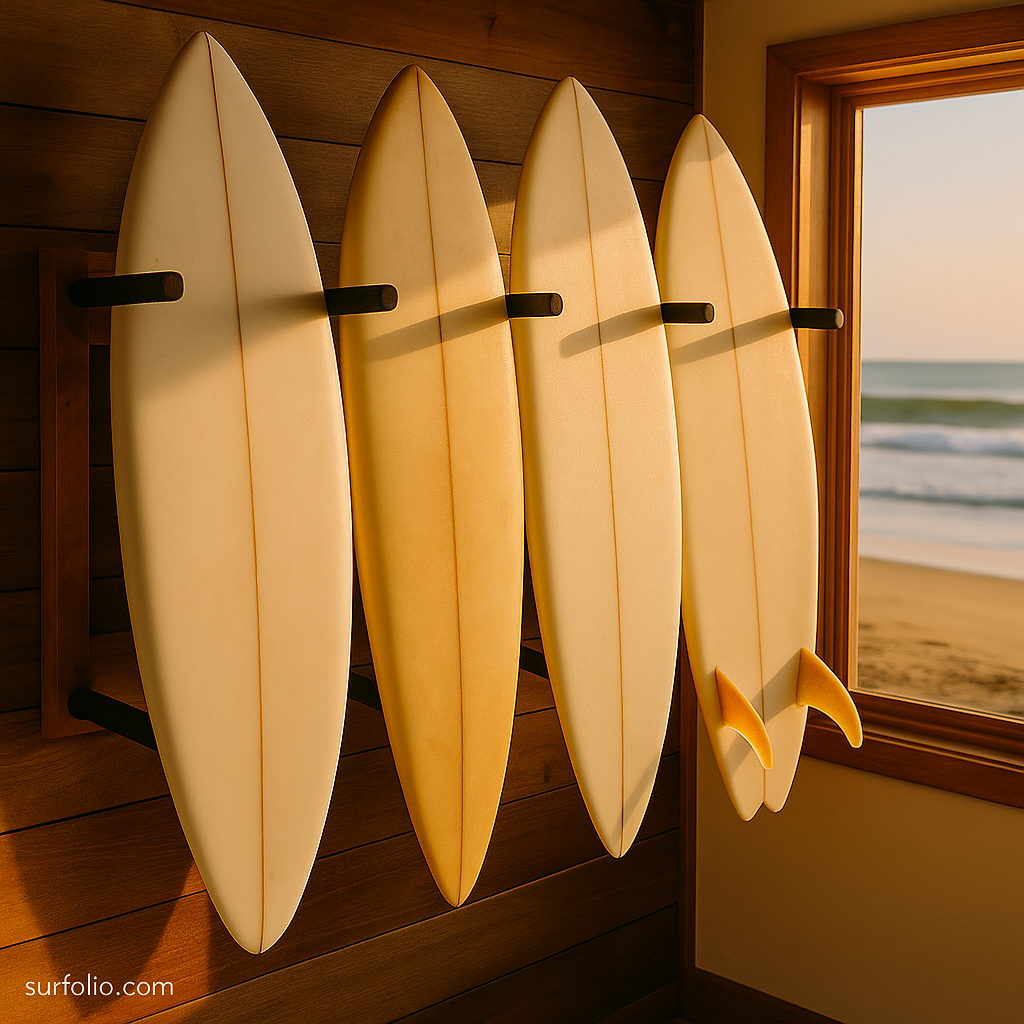
Every surfer knows that a good surfboard is an investment — and protecting it off the water is just as important as how you ride it. Whether you’re storing boards at home, transporting them on a road trip, or keeping them organized between sessions, a reliable surfboard rack keeps your gear safe, accessible, and in top shape.
Here’s how to choose the perfect rack for your surf lifestyle — one that fits your space, your surfboard quiver, and your peace of mind.
Why a Good Surfboard Rack Matters
A surfboard rack is more than a storage solution — it’s protection for your boards’ longevity and performance.
Without proper support, boards can:
- Warp from uneven pressure.
- Suffer dings from falls or poor stacking.
- Lose wax or traction pads if stored improperly.
A well-designed rack prevents these issues by keeping boards upright, evenly supported, and away from damaging surfaces.
Think of it as your surfboard’s “garage” — a place that keeps your investment safe and ready for the next swell.
Step 1: Determine Where You’ll Use It
Before diving into materials or designs, start by identifying your rack’s purpose and location.
Indoor Racks
Perfect for bedrooms, garages, or surf sheds. They prioritize aesthetics and accessibility. Wall-mounted and freestanding styles are popular here.
Outdoor Racks
Ideal for beach houses or yards. Look for weather-resistant materials like marine-grade stainless steel, aluminum, or treated wood.
Vehicle Racks
Designed for transport. These attach to your car roof or truck bed using straps or crossbars. Focus on security and aerodynamic stability.
Each location comes with its own priorities — protection from moisture, portability, or style — so start there.
Step 2: Choose Between Rack Types
There are three main rack styles, each suited to different storage needs.
1. Wall-Mounted Racks
- Best for saving space.
- Keep boards horizontal or angled along the wall.
- Great for displaying your collection while keeping boards off the floor.
- Tip: Ensure proper wall anchors for heavy longboards.
2. Freestanding Racks
- Ideal for garages or surf shops.
- Portable, often holding multiple boards vertically.
- Look for padded arms or foam supports to prevent rail pressure marks.
3. Ceiling Racks
- Great for smaller spaces or high-ceiling garages.
- Boards slide into overhead supports, maximizing floor space.
- Works especially well for longboards or travel quivers.
Step 3: Consider Materials and Durability
Surfboard racks are exposed to salt, sand, and sun — so material quality makes a difference.
Best materials:
- Stainless steel: Rust-resistant and long-lasting.
- Aluminum: Lightweight, weatherproof, ideal for roof racks.
- Hardwood or bamboo: Aesthetic and sturdy for indoor use.
- Heavy-duty plastic/PVC: Lightweight, affordable, and easy to clean.
Avoid: untreated metals or woods — they’ll corrode or warp quickly in humid environments.
Step 4: Look for Padding and Protection
The best racks include padding or rubber guards where the board rests. This prevents pressure dings and rail damage.
- EVA foam or neoprene padding is ideal.
- Ensure the padding covers the contact points fully — not just the edges.
- Replace worn padding regularly to maintain protection.
Pro tip: Some surf racks include adjustable arms to fit different board widths and tail shapes.
Step 5: Evaluate Capacity
How many boards do you own — and how many will you own in the next few years?
Racks come in single, dual, and multi-board setups:
- Single racks: Great for one prized board.
- Dual racks: Perfect for a shortboard/longboard combo.
- Multi-racks: Store entire quivers for families or collectors.
If you’re tight on space, opt for vertical stacking. For showrooms or aesthetics, horizontal display racks showcase the boards’ art beautifully.
Step 6: Stability and Mounting
Safety comes first — especially if you live in a windy or high-traffic area.
- Ensure wall studs or ceiling beams can handle the weight.
- For freestanding racks, choose a wide base or weighted bottom for balance.
- Roof racks should have secure tie-down points and anti-slip padding under straps.
If possible, test your rack’s sturdiness by gently pressing or shaking it before placing your boards.
Step 7: Aesthetic and Display
Your surfboard rack can double as décor — especially if your boards have unique designs.
- For modern interiors, minimalist metal or bamboo racks blend seamlessly.
- For beach house vibes, choose natural wood or rustic finishes.
- Consider racks that hold boards at an angle, letting your surf art shine.
A beautiful display rack turns your surf gear into part of your lifestyle aesthetic — not just equipment storage.
Step 8: Roof Racks for Travel
If your goal is safe transportation, prioritize these features in a vehicle rack:
- Padded crossbars: Prevent pressure dings.
- Durable straps with locking buckles: Secure boards at highway speeds.
- Aerodynamic design: Reduces drag and fuel impact.
- Water-resistant materials: Resist rust and salt buildup.
Brands like Thule, Yakima, and Curve offer great balance between durability and performance.
Always check local laws about overhang lengths or visibility requirements when transporting longboards.
Step 9: Maintenance Tips
Once you’ve got your ideal rack, a little upkeep goes a long way.
- Rinse off salt and sand regularly.
- Check screws and bolts for corrosion.
- Replace foam padding every season if it compresses or cracks.
- For wood racks, reapply protective coatings annually.
With care, a well-made rack can last a decade or more — protecting your boards season after season.
Final Thoughts
A reliable surfboard rack isn’t just about convenience — it’s about preserving the heart of your surfing experience. Whether you’re storing your first foamie or a lifetime collection of custom shapes, the right rack ensures they stay safe, organized, and ready for the next swell.
So, before you lean that board against the wall again, take the time to find a rack that supports not only your gear but your surfing lifestyle.
Because every session starts with one thing: your board being right where it should be.
